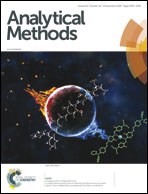Analytical pyrolysis in cultural heritage
Abstract
Analytical pyrolysis (Py), especially when coupled with gas chromatography and mass spectrometry (Py-GC-MS), is a powerful technique for the characterisation and identification of organic materials used in artwork. The thermal degradation of macromolecules (for example, resins, lacquers, proteins, polysaccharides, oils, modern synthetic polymers, etc.) using heat (thermal energy) generates smaller molecules (pyrolysis products) which are easier to identify and study. Some of these pyrolysis products are molecular markers allowing the identification of a specific material despite the sample’s complexity. A micro-sample (50–100 μg) is destroyed during the analysis but the lack of sample preparation makes Py-GC-MS a very attractive technique with a much reduced analytical time and cost compared to other chromatographic methods.

- This article is part of the themed collection: Analytical Methods Committee Technical Briefs

 Please wait while we load your content...
Please wait while we load your content...